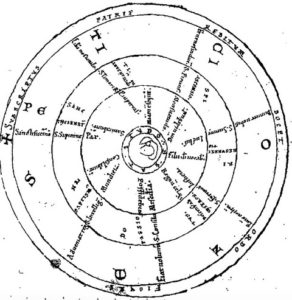
“Stand at the crossroads and look; ask for the ancient paths, ask where the good way is, and walk in it, and you will find rest for your souls.” Jer. 6:16a
Prayer has frequently crept into a back corner for me. The ‘I’m too busy’s take over. I look, leap, fall. I fall hard and awkwardly. (Picture Jim Carrey falling off the jetway and landing with legs splayed. That’s me.)
But, recently, I came across a book, published in 2018, that I missed and never heard any press about. (Self-help books all-too-often clog the bestseller shelves and do anything, if rarely, help.) I’ll chalk this discovery of rediscovery to divine appointment.
It’s called The Prayer Wheel.
It originated in a 12th century monastery, only recently resurfaced in a small private library in 2015 (NYC), and is known as The Liesborn Prayer Wheel.
It features concentric circles, featuring:
- Petitions from the Lord’s Prayer,
- then, Gifts of the Holy Spirit,
- followed by events in Christ’s life,
- then, a Beatitude blessing,
- and finally its corresponding Beatitude promise.
Each of these circles begin and end with ‘Praying the whole path.’ Much like the circular design, it’s meant to be endless and perfect in design. It’s outermost ring has the inscription The Order of the Diagram Written Here Teaches The Return Home. It feels very Middle-Earthian, and it taps into the creativity at which God permits people to visit Him.
I never knew this tool existed, and I’m so thankful the wheel was rediscovered near New York’s Metropolitan Museum of Art!
The Prayer Wheel website does a much better job describing its formation, usage, and application. How people are returning to these monastic practices, such as: fixed-hour prayer (divine office), labyrinths (walking prayer), and lectio divina (meditative scripture reading). Their site even features a downloadable wheel you can use!

But I love the foreword by James Martin, SJ, who writes, there’s no ‘one’ right way to use the wheel, much like there’s no ‘one’ right way to pray.
And, I’m constantly feeling the necessity to return to the ancient paths mentioned in the verse above. It shows me the importance of contemplation in my own life. These are divine appointments each and every time.
New isn’t always better, and in this case, the origin story, is as important as anything else in our daily lives.
No. Not just important.
Essential.
I pray this tool helps you in your prayer life today!


